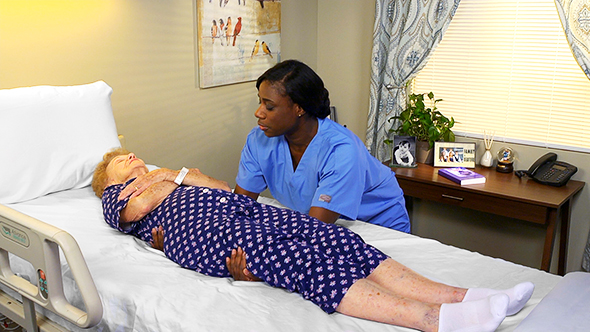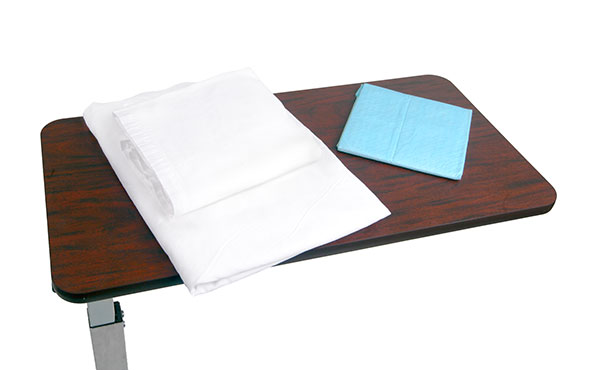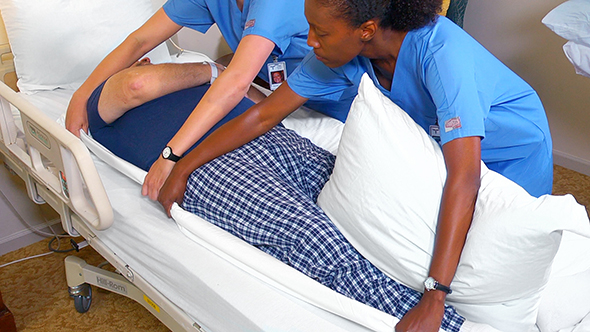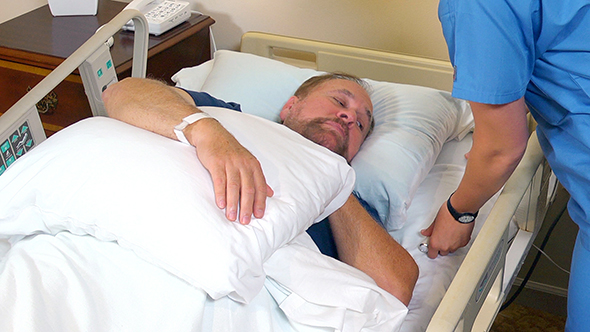Body Mechanics and Exercise
Select a Skill:
- » Moving the Person Up in Bed
- » Positioning the Person in Bed
- » Transferring the Person to a Chair or Wheelchair
- » Moving the Person to a Stretcher
- » Transferring the Person Using a Mechanical Lift
- » Assisting with Range-of-Motion Exercises
- » Helping the Person Walk
Take the Review Test:

Purpose

- Move the person to the side of the bed before turning or for repositioning and care.
- Sometimes you can move the person in segments by yourself. Use at least one co-worker and a mechanical lift or assist device for:
- Older persons.
- Persons with arthritis.
- Persons recovering from spinal cord injuries or spinal cord surgery.
- Using an assist device helps prevent pain, skin damage, and injuries.
- Turn the person onto his or her side to help prevent complications of bedrest and for certain procedures and care measures. Turn the person toward you or away from you, depending on his or her condition and the situation.
- After turning, position the person in good alignment, using pillows for support.
- Turn and re-position persons who cannot do this for themselves in bed.
- Logrolling is turning the person as a unit, in alignment, with one motion. This procedure keeps the spine straight and is less painful. Use it to turn:
- Older persons with arthritic spines, hips, or knees
- Persons recovering from hip fractures or spinal surgery
- Persons with spinal cord injuries.
Equipment
Roll cursor over items to see labels. For the purposes of clearly depicting the equipment, a barrier is not shown in this photo. When providing care, a barrier should always be placed on the surface before placing the equipment.

Drawsheet (lift sheet)
Folded flat sheet
Blue waterproof pad
Delegation
Follow delegation guidelines. Before positioning a person in bed, obtain this information from the nurse and care plan:
- The person’s dependency level
- How much help the person needs
- How many staff members are needed to safely complete the procedure
- The person’s comfort level and what body parts are painful
- Which procedure to use
- What assist devices to use
- What support devices are needed for positioning
- Where to place pillows
- What observations to report and record
- What patient or resident concerns to report at once
Preparation

- Observe quality-of-life measures.
- Review the information under Delegation and Safety and Comfort.
- Ask one or two co-workers to help you, as appropriate.
- Practice hand hygiene.
- Identify the person. Check the ID bracelet against the assignment sheet. Also call the person by name.
- Provide for privacy.
- Lock the bed wheels.
- Raise the bed for body mechanics. Raise the bed rails, if used.
Safety

- Use the method and equipment that are best for the person. The wrong method could seriously injure a person.
- Be sure to lock the bed wheels before positioning the person.
- When using an assist device, have at least one co-worker help you. If the person is tall or heavy, ask two co-workers to help. Do the same thing to logroll a person.
- To use a slide sheet, place it under the person. After moving the person, remove the slide sheet.
- To move the person in segments, move the person toward you, not away from you.
- Use good body mechanics when turning a person in bed.
- Keep the person in good alignment to help prevent injuries or skin breakdown.
- Do not turn a person away from you with the far bed rail down. Raise the bed rail on the side near you. Then go to the other side of the bed. Lower that bed rail if up. Turn the person toward you.
Comfort
- After moving the person to the side of the bed, move the pillow too. Position it under the person’s head and shoulders.
- After turning, position the person in good alignment. Use pillows to support the person in the side-lying position. Make sure the person’s face, nose, and mouth are not obstructed by a pillow or other device.
- After spinal cord injury or surgery, keep the person’s spine and neck straight. Usually, a pillow is not allowed under the head and neck. Follow the nurse’s directions and the care plan for positioning and pillow use.
Procedure Video
Audio Description: OFFFollow-up Care

- Position the person in good alignment.
- Provide for comfort.
- Place the signal light within reach.
- Lower the bed to its lowest position.
- Raise or lower the bed rails. Follow the care plan.
- Unscreen the person.
- Complete a safety check of the room.
- Practice hand hygiene.
Reporting/Recording
Report and record your observations, including:
- Who helped you with the procedure
- How much help the person needed
- How the person tolerated the procedure
- How you positioned the person
- Complaints of pain or discomfort
Review Questions
Select the best answer.
1. Which person is most likely to need logrolling for turning?
 A woman recovering from foot surgery
A woman recovering from foot surgery A woman with a hip fracture
A woman with a hip fracture A man with emphysema
A man with emphysema A man with dementia
A man with dementia
Select the best answer.
2. What is the correct way to move a person in segments by yourself?
Select the best answer.
3. For which person should you avoid placing a pillow under the head and neck?
 An older woman with arthritic hips
An older woman with arthritic hips An older man with a sleep disorder
An older man with a sleep disorder A woman with breathing difficulties
A woman with breathing difficulties A man recovering from spinal cord surgery
A man recovering from spinal cord surgery
Select the best answer.
4. After turning a person, which method should you expect to use for positioning?
 Have the side-lying person rest on one arm
Have the side-lying person rest on one arm Place a pillow under the lower arm and hand
Place a pillow under the lower arm and hand Straighten the person’s upper knee
Straighten the person’s upper knee Position a pillow against the person’s back
Position a pillow against the person’s back
Select the best answer.
5. How many people (total) does it take to turn and position a tall, heavy person in bed when using an assist device?
You have completed the Review Questions for this skill. To take the Review again select the Start Over button. To proceed to another skill select from the dropdown menu. Select the Home or Back button to proceed to the next section.

